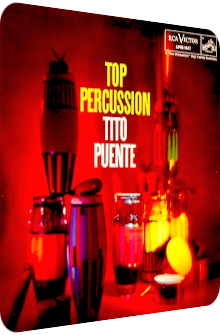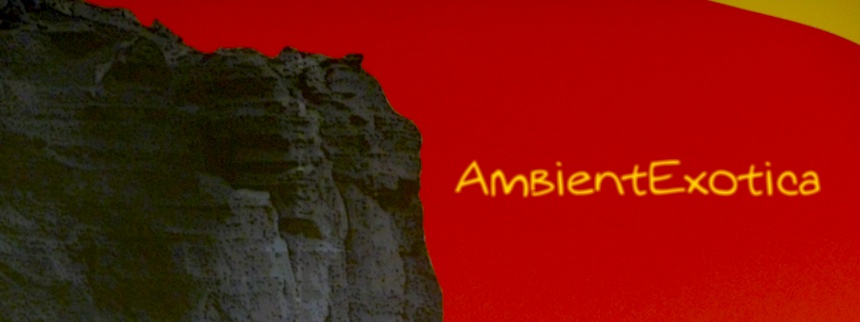
Tito Puente
Top Percussion
1957
Timbalero and vibraphonist Ernesto Antonio "Tito" Puente (1923–2000) is known for his Latin albums, their convoluted but accessible and feisty percussion segues and the introduction of the Mambo subgenre to North American ears. There is, however, only one album where he truly concentrates on the Latinized percussion side of things, and it may be both his most experimental or reduced and his best exotic work at the same time. I am talking about Top Percussion, released in 1957 on RCA Victor during the sudden rise of the Exotica craze. Even I hesitate to call Top Percussion a clear cut Exotica entry, but I know for sure that this percussive album beats the hell out of many similarly structured works created for like-minded listeners.
Puente's LP is strongly Latin due to the featured choir comprising of El Viejo Macucho, Marcelino Guerra and Merceditas Valdes who altogether interweave many a Cuban chant and appropriate reaction into the percussion thicket, but it is that latter thicket which really, truly and uniquely remains the most important and genre-expanding ingredient, ranging from Puente's own tom tom-esque timbales over loads of congas and cowbells to bongos, maracas and claves. Here is the essential twist: there are no melodies on this album in the classical sense. Only the chants of the choir – and a double bass on two of the eleven songs – add properly harmonious tone sequences to the arrangements. No strings, horns or reeds of any kind are ever used. The result is an enthralling and totally unique soundscape that is pieced together by Latinisms and exotic tropics of the mind. The sound quality is top notch, the reverb, echo, sustain and decay of each instrument enormously vivid.
The percussionists Tito Puente, Enrigue Marti, Francisco Urrutia, Mongo Santamaría (known for his work with Cal Tjader), Julio Collazo, Bill Correa as well as bassist Evaristo Baro join the choir with their signature instruments. Side A features six compositions of three writers and band members, while side B drops five works from the feather of Tito Puente, making each of them an inclusion that was specifically written with Top Percussion in mind, and rightfully so, for the focus on these instruments counteracts against the mellifluous euphony of literally all conductors, pianists and arrangers of the 50's.
A song by percussionist Mongo Santamaría launches the vivid album: Eleguara (also appearing under the name of Eléquana in some of Puente's other works) opens with Macucho's vocals, followed by the echo of the choir, churning maracas that sound much grainier than on many other percussion albums, and delicately liquid bongos. The title Top Percussion is immediately proven to the point, for there is anything else but the Latin vocals and the fissure-laden structure of the percussion instruments. The mood is curiously festive and at the same time contemplative, making this a more truthful Exotica outing. The following Bragada by band member Julio Collazo revs up the tempo and puts Puente's timbales more into the spotlight, but otherwise retains the same verve and aura that was in place heretofore, with preacher El Viejo Macucho and the choir's chants intact.
Francisco Aguabella's Obatalá Yeza follows, and it is a favorite of mine due to an even stronger dualism: the vocals are amicable and sizzling, but the many timbale droplets, conga accents and bongo backings are much denser, augment the ritualistic feel and change the stylistic range into Polynesian climes. While the many devices of Aguabella's second green-tinged contribution Alaumba Chemaché are again merged with a Latinized entanglement of various lead vocals and the choir, Julio Collazo's second offering Oguere Madeo focuses on a more laid-back groove which puts the vocals into the spotlight, but ultimately succeeds with a particularly hypnotizing framework; a strong feeling of a soporific trance ensues. The final piece of side A, Mongo Santamaría's Obaricoso, is once more painted with tribal colors in adjacency to the friendliest, sun-warmed Latin backing vocals of the whole album. The sound quality is truly magnificent on this piece, the echo and decay of the drums resemble the greenery of a purified forest. A great piece with differing nuances.
Sde B is solely dedicated to the compositions of Tito Puente. Four By Two concentrates first on the many different textures and tonal patterns of Puente's timbales and is then widened via the skills of the other players who altogether create a masterfully frantic, rapidly firing vocalless drumscape. Conga Alegre then places Mongo Santamaría and his congas into the limelight. The tempo increases even more, the drums are so loud, flamboyant and punchy that the backing choir seems to be far away in the distance. An artful depiction of wideness and a feast for exercising people, runners and torch throwers!
Both Ti Mon Bo and the addendum Mon Ti may be the biggest surprises, for they inject commonplace double bass melodies of the city-strolling kind on equally banal Salsa grooves, but this assertion sounds more negative than I intend it to be; these tunes are for listeners who crave for a more easygoing, stringent structure with many intermixed segues and varied additions rather than shape-shifting drum patterns that make up over 80% of the album. The ultimate Hot Timbales is the fastest, speediest and hyper-hectic opus of the album with anything but dramatically sped-up drums, showing the feat and prowess of each percussionist involved in the process of Top Percussion's creation.
Top Percussion does indeed live up to its name years before the percussion shtick permeated the Exotica and Latin genres. Most other percussion-fueled albums look tremendously ashen and pale in comparison, for Tito Puente did not only gather the best percussionists of that era around him, but makes sure that the surroundings feel right and splendid as well. With the exception of the couplet Ti Mon Bo and Mon Ti which hark back to Puente's more common song structures of his many other albums due to the bubbling – and melodious – double bass infusions, all other traces of melodies are exclusively performed by the vocal trio of El Viejo Macucho, Marcelino Guerra and Merceditas Valdes. The album is torn between Latin mannerisms such as Cuban chants, life-poeticizing timbres and playful reactions on the one hand and exotic foils such as a jungle-like freshness, incessant intimacy and blastful innocence on the other. This review was actually not that easy to write down, but this has to do with the large similarity of the arrangements. You can only add so much variety in a percussion-driven album without any orchestral part, and Tito Puente does it with great style. I am particularly fond of the encapsulated aura that wafts through every track.
Top Percussion is a jungle album, even though its front cover does not give away this fact. Since the serious approach of all involved artists is perceptible in every second, it is indeed an audacity to call this work an Exotica artifact, for there are no lachrymose sections or an attached Hollywood flavor, let alone pompously danger-evoking incidents. The leel of adventure is not thrown at the feet of the listener, he or she himself will perceive the enchanted forest-like buildups and refreshing vistas of rain forests through the straightforward honesty of the arrangements. No aural makeup is involved, just the exciting interplay amid the percussion and the integration of the choir. Top Percussion plays in a league of its own indeed, itself being the only team. It is luckily available in a 12-track digital version on all digital music stores with the additional tune Night Ritual placed as a new outro. If you want a truly exceptional, one of a kind Exotica-like album, consider Top Percussion.
Exotica Review 183: Tito Puente – Top Percussion (1957). Originally published on Feb. 23, 2013 at AmbientExotica.com.
